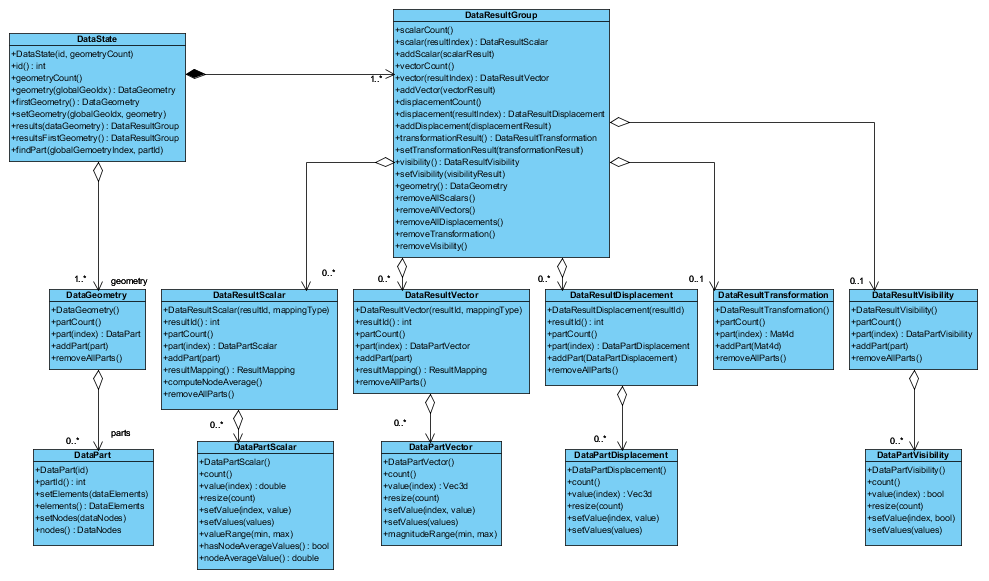cee::ug::DataPartDisplacement
-
class
DataPartDisplacement: public RefCountedObject Displacement results for a part.
A displacement result value is a three dimensional vector giving a magnitude and a direction for the displacement of a node. DataPartDisplacement contains an array of vectors specifying the displacements for all nodes in a part.

A DataPartDisplacement contains the result values corresponding to a DataPart. This means that the number of result values in each displacement part must match the number of nodes in the corresponding part. DataPartDisplacement is a child of a DataResultDisplacement in the same way as a DataPart is a child of a DataGeometry. The DataResultDisplacement must have the same number of child parts as the DataGeometry.

Note! The class is reference counted and can be shared between multiple results. Remember that since this object is reference counted it should never be created on the stack.
Values are inserted using setValue(), setValues() or setValuesFloat(). Get the number of values with count() and query a specific value using value() with an index.
Note! The values are the absolute node positions, not just the relative offset to the undisplaced node position.
Example
Example of how to add a displacement result to a geometry consisting of only one triangle.
Create the DataResultDisplacement object with a unique id.
int dispResultId = 1; cee::PtrRef<cee::ug::DataResultDisplacement> dispResult = new cee::ug::DataResultDisplacement(dispResultId);
The result array must have one value for each node coordinate in the triangle. Remember that the array must be resized before inserting the results.
cee::PtrRef<cee::ug::DataPartDisplacement> dispPart = new cee::ug::DataPartDisplacement(); dispPart->resize(3); dispPart->setValue(0, cee::Vec3d(1.0, 0.0, 0.0)); dispPart->setValue(1, cee::Vec3d(0.0, 0.0, 0.0)); dispPart->setValue(2, cee::Vec3d(0.0, 1.0, 0.0));
Number of parts in the DataResultDisplacement must match number of parts in the geometry. Displacement values must also fit the corresponding part in the geometry. Here the part is a single triangle with three nodes, hence a results array with three vectors will fit.
Add the displacement part to the result displacement.
dispResult->addPart(dispPart.get());
For each geometry in a state there is a result group binding the geometry and results.
Add the result displacement to the state (DataState) for the corresponding geometry (DataGeometry) geo
state->results(geo.get())->addDisplacement(dispResult.get());
See the complete source code at: UnstructGrid: A Simple Model with Results
Tutorials
See also
UnstructGrid: A Simple Model with Results
Public Functions
-
DataPartDisplacement() Constructs an empty object.
-
size_t
count() const Returns number of displaced nodes in this DataPartDisplacement.
-
Vec3d
value(size_t index) const Returns the absolute node position for the node at the given index.
Note! The value is the absolute node position, not a relative value to the undisplaced node position
-
const double *
rawValuePointer() const Returns a raw pointer to the absolute node positions.
-
double *
rawValuePointer() Returns a modifiable raw pointer to the absolute node positions.
-
void
resize(size_t count) Sets the number of values in the object.
The current values in the object will be kept up to the given count (if shrinking).
-
void
setValue(size_t index, const Vec3d &value) Sets the absolute node position for the displaced node.
Note! The value is the absolute node position, not a relative value to the undisplaced node position
Warning
The specified index must be a valid index. Either call one of the setValues() methods or call resize() prior to calling this method.
-
void
setValues(const std::vector<Vec3d> &values) Sets the absolute node positions for the displaced nodes.
Note! The values are the absolute node positions, not relative values to the undisplaced node positions
-
void
setValues(const double values[], size_t vectorCount) Sets the absolute node positions for the displaced nodes.
Note! The values are the absolute node positions, not relative values to the undisplaced node positions
See also
-
void
setValuesFloat(const float values[], size_t vectorCount) Sets the absolute node positions for the displaced nodes.
Note! The values are the absolute node positions, not relative values to the undisplaced node positions
Note! That this is only provided for convenience, and that the nodes will internally be stored as doubles
-

